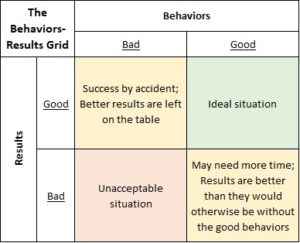“Review” feedback, rather than being just the feedback given to employees during formal, annual performance appraisals, is any feedback that connects the dots among multiple observations and data points to draw a more general picture of job performance. When giving such feedback, managers often zero in on results as the driver of the feedback. Good results attract positive feedback, and bad results attract negative feedback. But performance is not so one-dimensional, and there aren’t just two types of feedback.
The Behavior-Results Grid defines performance in two dimensions, and that means there are actually four different quadrants of possible feedback to consider. Results can be either good or bad, and behaviors can be either good or bad. Of course, good and bad is really a continuum on both dimensions, so the idea of four quadrants is a simplification of the infinite number of actual situations. But the grid serves as a guide for balancing performance assessment between the two dimensions and reminding us to recognize situations where performance in one dimension is good and performance in the other is bad.
The ideal situation is when both results and behaviors are good. It can be reasonably assumed that good behaviors have led to good results, and that’s the way it’s all supposed to work. It’s just as clear when results are bad and behaviors are bad. The other two quadrants are trickier.
There are a couple of explanations for situations when behaviors are good but results are bad. It could be that the bad results would be much worse if not for the good behaviors. It could also be that the good behaviors have not yet had enough time to develop into good results. In either case, it’s more effective for the manager to provide the right feedback given the quadrant rather than follow the common path of giving negative feedback for bad results.
Situations when results are good and behaviors are bad can be equally confounding. The reality is that good results may very well be achieved by accident. Or, good results could almost certainly be better if the right behaviors were in place, and that means greater success is being left on the table. In either case, a manager would be wrong to give positive feedback simply because the results are good.
In summary, managers must be sure to think in two dimensions when providing “review” feedback to employees, and the Behavior-Results Grid is a good guide toward that thought process. For more on how to maximize the effectiveness of “review” feedback, click on the link below to view the final module of the free video training course The 7 Core Management Behaviors.
Module 7 of The 7 Core Management Behaviors
